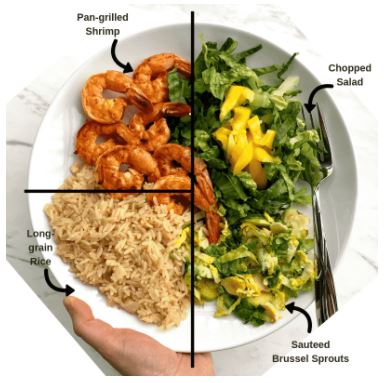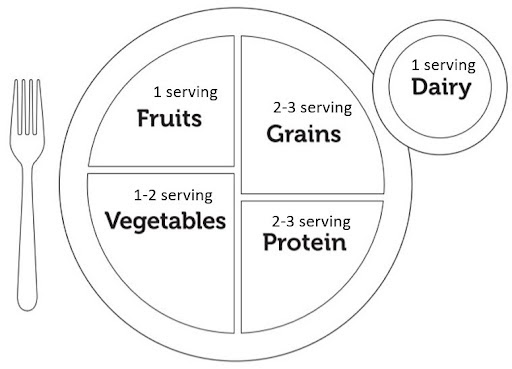
Molly Nguyen
BSc (Human Nutrition)
A healthy diet is crucial in maintaining physical and mental wellbeing as well as preventing malnutrition and a range of chronic diseases.
There are several approaches to the Healthy Plate Model but they all have one thing in common. Balanced diet means correct portion sizes and a mix of vegetables, fruits, grains and protein.
We should select colourful vegetables which should take nearly half of our plate. Fish, poultry, nuts and beans (as our protein source) should be one quarter of our plate. Grains (aim for whole grains) shouldn’t be more than a quarter of our meal.
Now, let’s take a closer look at the healthy plate model and how to use it.
What is the Healthy Plate Model
For decades, health practitioners have been applying the scientific data behind the recommended dietary intake to educate the general public on how to consume a balanced and healthy diet.
According to the World Health Organization, the basic principles of a healthy diet for adults include at least 400g of fruit and vegetables, less than 10% of total energy intake free from sugar, less than 30% of energy intake from fat, and less than 5g of salt per day.[1]
This principle of dietary recommendation, however, could be overwhelming and confusing for the general public.
It is important that scientific nutrition messages are universally understood by individuals, families and communities to help them achieve a healthy dietary pattern.
By acknowledging this barrier, many dietary guidelines have translated the nutrient recommendation to food and beverages recommendation by promoting a healthy dietary pattern as a whole, rather than focusing on nutrients and foods in isolation.
We should aim for at least 400 grams of fruit and vegetables daily
A plate model is a simple visual nutrition recommendation developed by nutrition experts to provide practical dietary advice and promote healthy eating patterns across the population.[2]
What does the Healthy Plate Model look like?
The healthy plate model (sometimes referred to as the perfect plate) is a simple format of healthy eating guides for consumers to create a healthy and balanced meal. The healthy plate model is also used by many nutrition educators across sectors to explain and advise the public on portioning and making healthy food choices.
In this model, a plate serves as a pie chart that is divided into sections that represent the relative proportions of each of the food groups in which people should include on their “healthy plates”.[2]
The national food guides are the main frameworks to design healthy plate models, translating professional nutrition messages into simple visual designs that can be easily understood and memorised by the general public.[3]
There is a diverse range of food guides currently existing across different organisations and countries, resulting in different versions of healthy plate models. Although the designs are varied, there is no substantial difference in the categories and recommended proportions of the main food groups.
In this section, we will look at the Healthy Eating Plate by Harvard T.H. Chan School of Public Health as an example of a healthy plate model.[4]

This version of the healthy plate model is based exclusively on the best available science and forms the basis of a healthy diet.[4] According to the Healthy Eating Plate, people should:

Fill half of the plate with fruits and vegetables:
- Eat plenty of colourful varieties of fruits and vegetables.
- The rainbows of fruit and vegetables are rich in dietary fibre, vitamins, minerals, phytochemicals and antioxidants which protect the body against many chronic diseases such as heart disease, stroke and certain cancers.
- Potatoes and French fries are not considered vegetables in the Healthy Eating Plate model due to their negative effect on blood sugar similar to refined grains and sweets.

Fill quarter of the plate with whole grains
- Aim for grain foods that have the highest amount of whole grains (whole wheat, barley, whole grain bread, quinoa, oats, brown rice, wholemeal pasta) instead of refined grains (white rice, white bread, breakfast cereals).
- Whole grains have better health benefits and are high in dietary fibre, vitamins and minerals, whereas refined grains have fewer nutrients and have negative impacts on weight gain, heart disease and diabetes.

Fill quarter of the plate with healthy protein
- Protein is a building block for body tissues. It is also a good source of vitamins and minerals including vitamin B, iron and zinc.
- Aim for healthy protein sources such as fish, poultry, beans and nuts.
- Limit red meat and avoid processed meat since consumption of red and/or processed meat is linked to increased risks of colon cancer, heart disease and diabetes.
RELATED — Diet and the Brain: Proteins

Consume small amounts of healthy oils
- Choose healthy vegetable oils such as olive, macadamia nut oil, flaxseed oil and other plant-based oils that are high in unsaturated fat (healthy fat) as they reduce ‘bad’ cholesterol and are better for the heart compared to animal fats.
- Limit butter and avoid trans fat (unhealthy fat).
RELATED — Diet and the Brain: Fats

Drink water, coffee or tea
- Make water your first choice over other drinks as water is essential to the body and contains no energy (calorie). An alternative can be coffee or tea with little or no added sugar.
- Limit milk and milk products to 1-2 servings per day and limit juice to 1 small glass per day because of the high sugar content in juice.
- Avoid sugary drinks such as fizzy drinks, energy drinks, sport drinks since the consumption of sugary drinks are linked to obesity and diabetes.
RELATED — Diet and the Brain: Sugar
Stay active
- Besides a healthy diet, being physically active is important in weight control.
RELATED – See our page Activities and Performance for tips on how to stay active.

The healthy plate models simplify portioning of a meal onto a single dinner plate.
However, the guides can be applied no matter which types of dishware or meals that you eat.
When cooking a mixed meal such as pasta, curry or stir-fry dishes, you can apply the same principle of the Healthy Eating Plate.
This means to proportion half of the ingredients to a variety of colourful vegetables and/or fruits, a quarter of the ingredients to whole grains, and a quarter of the ingredients to be healthy proteins. The Healthy Eating Plate focuses on the diet quality that promotes a healthy, balanced meal in the context of an individual’s personal and cultural preferences.[4]
RELATED — We talked in more detail about balanced diet and individual preferences in our article about Mindful Eating.
Different versions of the Healthy Plate Model
There are some other common versions of the healthy plate models that are based on the national healthy eating guides from Dietary Guidelines for Americans, Australian Guide to Healthy Eating, and Eating and Activity Guidelines for New Zealand Adults.
Even though there are few variations in the proportions and subcategories of each food group among different versions of the healthy plate models, all models emphasize the basic principles of a balanced and healthy meal, which include:
- Make most of your meal vegetables and fruits (40-50% of the plate)
- Choose whole grains and high fibre grains over refined grains (25-30% of the plate)
- Choose healthy protein sources such as fish, poultry, eggs, legumes/beans, lean meat instead of processed meat (25-30% of the plate)
- Drink plenty of water
- Choose low or reduced-fat milk and dairy products (2-3 servings/d).
The Food Pyramid
Most people are accustomed to using the food pyramid model as a healthy eating guide for many years. However, please note that the Food Pyramid is currently being debated in many circles and is being revised.
The food pyramid was first introduced to address the rising food prices in Sweden in the 1970s.[8] The Swedish food pyramid model guided their citizens to eat healthy while on a low budget.
Since then, the food pyramid was widely distributed and has continued to evolve as a nutrition guide and education tool in many other countries. The introduction of the food plate model does not necessarily mean the food pyramid is irrelevant or obsolete.
In fact, the Healthy Eating Pyramid and Healthy Eating Plate complement each other and are available to be used separately or in combination in various nutrition education settings.[4]
Although, the evidence showed that a large majority of adults and children prefer the design of plates over pyramids because the plate model was considered more visually attractive, more informative and easier to interpret compared to the pyramid model.[3,9]

Other research also demonstrated many benefits of using the healthy plate model as a nutrition guide for the general public, including:
- Enhancing the connection between scientific dietary theory and dietary practice
- Enhancing individual’s memory and understanding of healthy diet through visual message
- Simple guide for people to remember the right proportion of each food group in a well-balanced meal without a measuring device
- An example of a healthy plate model can be customized to an individual’s needs, preferences and budget
- An easy way for people to get all the essential nutrients regardless of the type of meal, cuisine, or occasion
The advantages of the healthy plate model are significantly helpful for public health nutrition to continually enhance the nutrition guide and effectively educate people on healthy food choices and healthy eating.
RELATED — If this seems to be too structured, then perhaps you should learn more about Intuitive Eating.
Diabetes and the Healthy Plate Model
The healthy plate model is an effective tool in type 2 diabetes prevention and management.
The recommended food groups from the healthy plate models are closely aligned with the evidence behind the dietary recommendations for diabetes prevention and management.
RELATED — Diabetes: Early Signs, Causes, Types and Treatment
The American Diabetes Association has developed the Diabetes Plate Method as a simple guide for people with diabetes to create healthy meals that positively impact their blood sugar.
Although there are few differences in the type and amount of foods from the Diabetes Plate Method compared to Healthy Eating Plate, it still covers the basic principle of a healthy meal that can be used for all individuals with or without diabetes.[10]

- Fill half of the plate with non-starchy vegetables such as broccoli, cauliflower, cabbage, carrot, green beans or tomatoes.
- Fill quarter of the plate with lean protein foods such as fish, poultry, lean meat, beans or tofu.
- Fill quarter of the plate with carbohydrate foods such as whole grains, starchy vegetables (potato), legumes, fruits, milk or yoghurt.
- Drink water or other low-calorie beverages such as unsweetened tea/coffee or sparkling water.
The evidence suggested that 85-99% of people using the plate model for diabetes were able to plan their meals correctly with a significant increase in fruit and vegetable consumption.[11]
The Healthy Plate Model can help with diabetes prevention and management
This highlights the effectiveness of using the healthy plate method to educate people with diabetes on meal planning, which helps keep their blood sugar under control and prevents the risk of diabetes complications.
Building a Healthy and Balanced Diet
Following the guidelines presented through the healthy plate model has shown to be effective in lowering the risk of chronic diseases, improving adherence to dietary recommendations and improving diet quality.
However, the relative sections of the healthy plate model only visually represent the relative proportion of each food group for a healthy meal. They are not based on a certain number of calories or serving sizes per day because an individuals’ energy and nutrient needs vary based on age, gender, body size, lifestyle and degree of physical activity.
The national dietary guidelines are a great resource with more specific and detailed recommendations of energy intake and serving size of food from each group for individuals across different age groups.[6,7,12]
In this section, we will use the 2020-2025 Dietary Guidelines for Americans as a guide to demonstrate the daily recommended intake of each food group and ways to use the MyPlate model to meet the recommendations.[12]
How many servings per day do you need?
The estimated energy needs per day for healthy adults aged 19 to 30 are 1800-2400 calories in females (7560-10,080 kJ) and 2400-3000 calories in males (10,080-12,600 kJ).
The energy needs per day for adults aged 31 to 59 are generally lower, with 1600-2200 calories in females (6720-9240 kJ) and 2200-3000 calories in males (9240-12,600 kJ).[12]
The daily recommended amounts for each food group at the 2000-calorie level are outlined below[12]:
| Food Group | Daily Recommended Amount at 2000 calorie-level (serving) | Example of 1 serving size |
| Vegetables | 2 ½ | ½ cup of raw/cooked/canned vegetables; or 2 cups of leafy salad greens |
| Fruits | 2 | 1 cup of raw/frozen/cooked/canned fruit; or ½ cup of dried fruit |
| Grains | 6 | 1 slice of wholegrain bread; or ½ cup of cooked rice, pasta or cereal; or ½ cup of cooked porridge |
| Protein Foods | 5 ½ | 28 g of lean meat, poultry or seafood; or 1 egg; or ¼ cup of cooked beans, peas or lentils; or 1 tbsp of peanut butter |
| Dairy | 3 | 1 cup of low-fat milk, yoghurt or soy milk |
(The amount will vary for those who need more or less than 2000 calories per day)
How to translate the recommended servings of each food group onto MyPlate?
Based on a 2000 calorie-diet

Fill ½ plate with fruits and vegetables:
- ½ serving of fruit and 1 serving of vegetables
- Having half of the plate with fruits and vegetables at each meal will meet the recommendation of at least 2 servings of fruit and 2 servings of vegetables per day
Fill ¼ plate with grains:
- 2 servings of grains
- Having a quarter of the plate with grains at each meal will meet the recommendation of 6 servings of grains per day
Fill ¼ plate with protein foods:
- 2 servings of protein foods
Having a quarter of the plate with protein at each meal will meet the recommendation of at least 5 servings of protein per day
Based on a 2400 calorie-diet

Fill ½ plate with fruits and vegetables:
- 1 serving of fruit and 1-2 servings of vegetables
- Having half of the plate with fruits and vegetables at each meal will meet the recommendation of at least 2 servings of fruit and 3 servings of vegetables per day
Fill ¼ plate with grains:
- 2-3 servings of grains
- Having a quarter of the plate with grains at each meal will meet the recommendation of 8 servings of grains per day
Fill ¼ plate with protein foods:
- 2-3 servings of protein foods
Having a quarter of the plate with protein at each meal will meet the recommendation of at least 6 servings of protein per day.
The USDA’s MyPlate has designed an application called MyPlate Plan Widget that allows individuals to customize their healthy plate models (MyPlate Plan) corresponding to their energy and nutritional needs.[13]
All examples given above follow the Healthy U.S.-Style Dietary Pattern. To know the appropriate dietary pattern and daily intake of each food group for you, consider using the National Food Guide or consulting your healthcare provider.
Conclusion
The healthy plate model is used alongside the healthy eating guide as a visual and simple guide to healthy eating in children and adults. The healthy plate model can be used by nutrition educators to effectively deliver nutrition messages or by individuals to easily create a healthy and balanced meal at home.
By following the guidelines presented through the healthy plate model, people can eat a variety of nutrient-dense foods and beverages across all food groups within the recommended amount and their calorie needs.
The public health nutrition and nutrition educators should evaluate and improve the healthy plate model to inform the public on healthy eating and chronic disease prevention since the science behind nutrition is continually providing new evidence.
Related Questions
1. Is there a Healthy Eating Plate for kids?
Besides the Healthy Eating Plate, nutrition experts also developed a more colourful and appealing version of the Healthy Eating Plate for kids. The Kid’s Healthy Eating Plate helps to educate children on making healthy food choices and snacks and staying active.[14]
2. What are some examples of Healthy Plate recipes?
For examples of healthy recipes you can visit our Recipe page where you will find nutritious and easy to make meals for every occasion.
3. What is the Eatwell Guide?
The Eatwell Guide was published by the Public Health England (PHN) to replace the eatwell plate as the UK’s healthy eating tool.
The Eatwell Guide visually represents the types and proportions of each food group that is consistent with the government dietary recommendations to achieve a healthy balanced diet.[15]
I hope you liked the article. If you still have questions on how to start with the Healthy Plate Model, you can simply post your question in the comments below, and we will get back to you.
With a special interest in food and nutrition, Molly’s passion is to become a dietitian with expertise in nutrition and chronic diseases. Molly’s aim is to advocate the role that diets play in the prevention, treatment and reversal of non-communicable diseases that many are facing nowadays. By using the scientific evidence behind healthy eating, Molly’s focus is to help people follow a healthful and balanced diet to achieve their desired health outcomes.
References
(1) World Health Organization. (2020). Healthy Diet. https://www.who.int/news-room/fact-sheets/detail/healthy-diet
(2) Camelon, K. M., HÅDell, K., JÄMsÉN, P. T., Ketonen, K. J., KohtamÄKi, H. M., MÄKimatilla, S., TÖRmÄLÄ, M.-L., & Valve, R. H. (1998). The Plate Model: A Visual Method of Teaching Meal Planning. Journal of the American Dietetic Association, 98(10), 1155-1158. https://doi.org/https://doi.org/10.1016/S0002-8223(98)00267-3
(3) Hunt, P., Gatenby, S., & Raynert, M. (2007). The format for the National Food Guide: performance and preference studies. Journal of Human Nutrition and Dietetics, 20(3), 210-226. https://doi.org/10.1111/j.1365-277X.2007.00778.x
(4) Harvard T.H. Chan School of Public Health. (2021). Healthy Eating Plate. Harvard University. https://www.hsph.harvard.edu/nutritionsource/healthy-eating-plate/
(5) U.S. Department of Agriculture. (2020). MyPlate. USDA. https://www.myplate.gov/
(6) Australian National Health and Medical Research Council. (2017). Australian Guide to Healthy Eating. National Health and Medical Research Council. https://www.eatforhealth.gov.au/guidelines/australian-guide-healthy-eating
(7) Ministry of Health. (2020). Eating and Activity Guidelines for New Zealand Adults Wellington, NZ, Ministry of Health. www.health.govt.nz
(8) Smallwood, K. (2013). Who invented the food pyramid? http://www.todayifoundout.com/index.php/2013/09/invented-food-pyramid/
(9) Talati, Z., Pettigrew, S., Moore, S., & Pratt, I. S. (2017). Adults and children prefer a plate food guide relative to a pyramid. Asia Pacific Journal of Clinical Nutrition, 26(1), 169-174. https://doi.org/10.6133/apjcn.112015.04
(10) The American Diabetes Association. (2020). What is the Diabetes Plate Method? https://www.diabetesfoodhub.org/articles/what-is-the-diabetes-plate-method.html
(11) Raidl, M., Spain, K., Lanting, R., Lockard, M., Johnson, S., Spencer, M., Sant, L., Welch, J., Liddil, A., & Hartman-Cunningham, M. (2007). The healthy diabetes plate. Preventing Chronic Disease, 4(1), A12-A12. https://pubmed.ncbi.nlm.nih.gov/17173720
(12) U.S. Department of Agriculture, & U.S. Department of Health and Human Services. (2020). Dietary Guidelines for Americans, 2020-2025 (9th ed.). USDA. https://www.dietaryguidelines.gov/
(13) U.S. Department of Agriculture. (2020). MyPlate Plan Widget. USDA. https://www.myplate.gov/myplate-plan/widget
(14) Harvard T.H. Chan School of Public Health. (2015). Kid’s Healthy Eating Plate. Harvard University. https://www.hsph.harvard.edu/nutritionsource/kids-healthy-eating-plate/
(15) (PHE) Public Health England. (2016). From Plate to Guide: What, why and how for the eatwell model, Public Health England. https://assets.publishing.service.gov.uk/government/uploads/system/uploads/attachment_data/file/579388/eatwell_model_guide_report.pdf










Your content is enough good to give proper information. It is very much pleasure to learn new things. You did a excellent job. Keep it up.